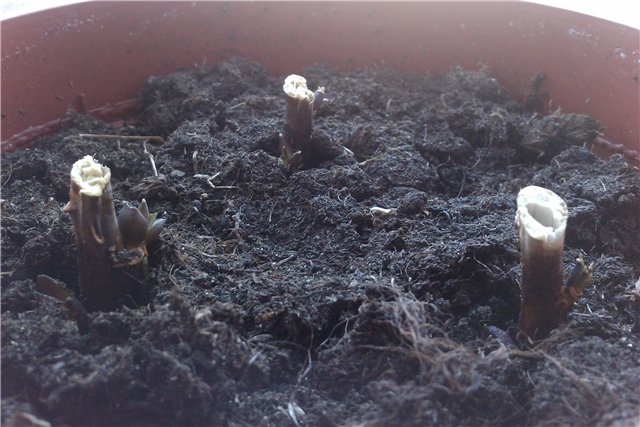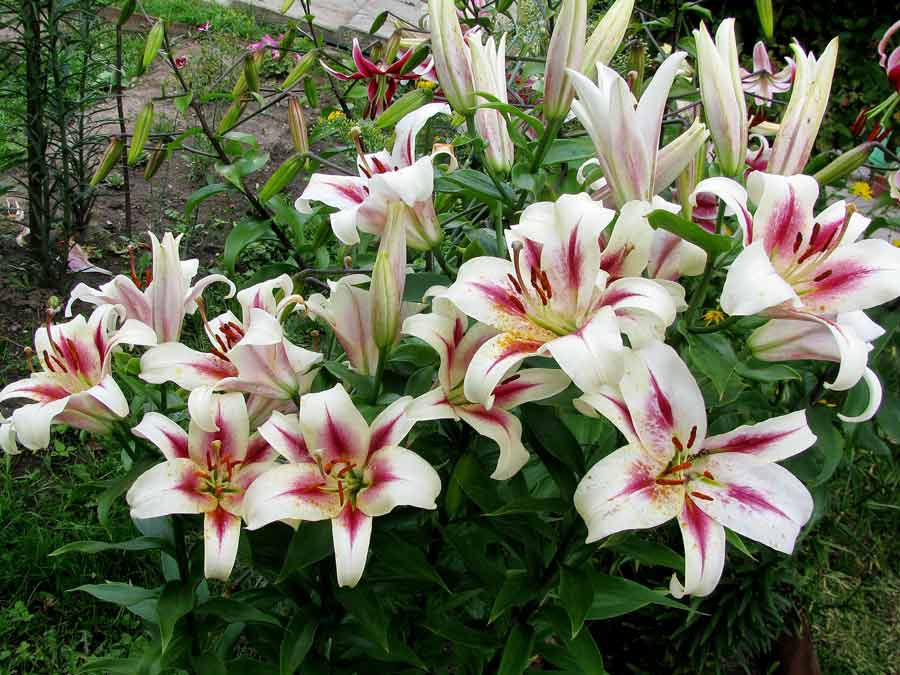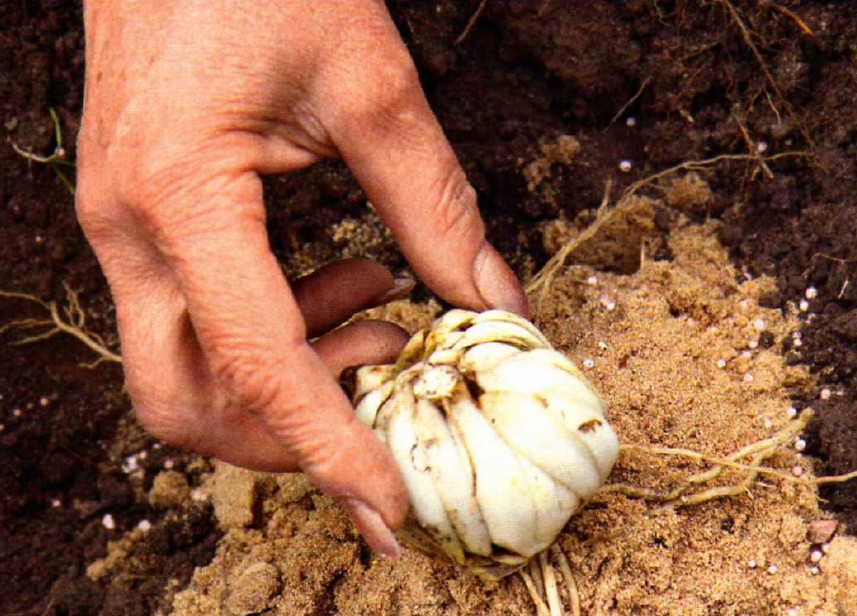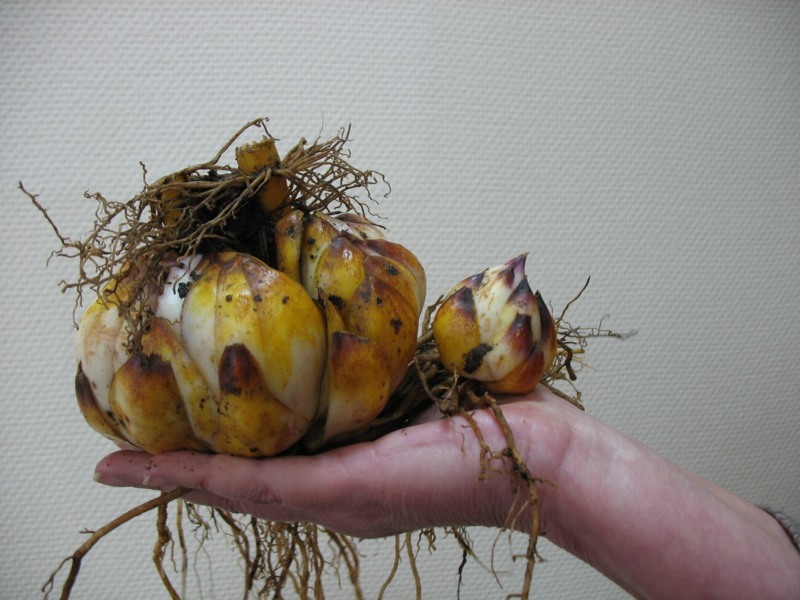Content:
Lilies are loved by many flower growers. They always delight with beautiful lush flowering, unpretentious, can grow on various soils, tolerate any climatic conditions well. They can be grown outdoors as well as at home. With the exception of some nuances, caring for lilies in the garden and at home is almost the same. Plants require watering, loosening the soil, feeding. Below it will be described in detail about the features of growing flowers planted in a summer cottage or growing in a room, as well as how to properly take care of lilies.
Growing lilies at home
You can breed lilies on the windowsill. Many varieties are suitable for these purposes:
- Asian, oriental, long-flowered hybrids;
- tubular, dwarf, aquatic species;
- golden, lovely, royal varieties.
And, of course, indoor water lilies - Amazonian lilies, amaryllis, hippeastrum. They bloom, just like garden species, from June to August inclusive.
When to plant
You can plant a lily in a pot all year round. If it is supposed to decorate a balcony or veranda with it, planting is carried out in the spring (after the 20th of March). In this case, the plant will bloom in May (second half). So that flowering can continue later, repeat the next plantings every 14 days. If you plant a flower in the fall (at the end of September), then it will bloom by December.
Preparing for landing
Before planting the bulbs, they need to be kept in the refrigerator for 16-20 days. The required temperature is up to -6 ° С. Then the onions are placed in a pinkish solution of potassium permanganate for 1.5–2 hours. After that they are treated with a stimulating drug, epin, zircon, succinic acid, phytosporin are used, and trace elements are added.
For one onion, take a container with a diameter of 16-18 cm. In a more spacious pot (diameter 40 cm), you can place 3-4 onions. If the plant is 1.5 m tall, choose a sufficiently deep container (at least 35–40 cm).
You must first prepare the soil. For this it is recommended to mix:
- sod land (1 part);
- compost (1 part);
- humus (part 1);
- mineral fertilizers (potassium, magnesium, phosphorus, nitrogen, 50 g per 1 liter of soil mixture).
Before planting the plant, spill the earth with a hot solution of potassium permanganate.
It is best to grow lilies on the eastern or western windowsills. If the flowers are on the south side, they need to be shaded. Comfortable temperature 14-20 °.
Landing
Expanded clay, pebbles or crushed bricks (5 cm layer) are placed on the bottom of the pot. Pour the earth on top with a layer of 10 cm. Lay out the bulbs so that the tops look up. Slightly press their bottoms to the soil. Sprinkle with earth half (15–20 cm). Leave a distance of 7 cm to the upper sides. After the young growth appears, as well as in the process of growth, it will be necessary to periodically add soil. Watered with warm water.
Lily in a pot: home care
It is now necessary to ensure proper care of the lily.
- After the flower has been planted, it must be left in a cool, dark place. Water the plant as the earthen coma dries once every 3 days.
- When the first sprouts appear, the young seedling can be placed on the windowsill. Now you need to feed him with organic substances. After 7 days, re-fertilization will be required (using nutritious potassium-phosphorus formulations).
- During the initial growing season, they are sprayed 2 times a week with an aqueous solution, adding a growth stimulator to it.
- When the seedling reaches 10 cm, sprinkle it with earth to the edge of the container.
- You need to water the lily daily. The soil is periodically loosened to a depth of 5 cm. They are fed with organic matter, mineral complexes 1 time in 7 days. Ventilate the plant regularly.
- If you plan to keep the lily on the balcony or terrace in the summer, it must be tempered. First, the flower is taken out into the fresh air for a short time - 15–30 minutes. It should not be exposed to direct sunlight. Gradually increase the time, adding 30 minutes. After the plant has been outdoors for at least 4 hours and does not wither, you can leave it for the whole day. But it is important to remember that you can take a lily to the balcony only when she is 1 month old.
- It will be very good to spray the plant with water from a spray bottle every day before the buds begin to bloom. This will have a beneficial effect on its growth and development.
How to care for lilies after flowering
Lily can grow in a pot for 3-4 years. After flowering, she needs to provide favorable conditions for wintering. The plant should bloom, but the leaves and stems are not cut off, watering is reduced to 1 time per week, spraying is stopped. They must naturally dry themselves, give all the nutrients to the bulbs.
When all the aboveground parts are dry, pruning is done. The top layer of the earth is renewed by removing 5–6 cm, fresh soil is added and the pot is removed. It can be covered with a black plastic bag and put in a cool place: basement, cellar, garage. The temperature there should be 4-5 ° C.
Bulbs are stored for 2-3 months. From time to time you need to water the soil, if it is dry, watch out when shoots appear. After the first shoots are formed (up to 2.5–5 cm in height), the pot is transferred to a bright, warm room with a temperature of 10 ° C. Then it can be placed in a room where it is 18 ° C. After 2 weeks, buds should appear. When they begin to acquire color, the container is placed on the windowsill.
Some growers recommend replanting the lily every year. After the flowering is completed and all the greens wither, then after 2 weeks the bulbs are dug out. The formed children are deposited for further reproduction in separate pots. And large specimens are washed with warm water. Excess shoots are cut by 5 cm and the bulbs are placed in a manganese solution for half an hour. Then they need to be pulled out, dried for 2 hours.
Next, the planting material must be folded into prepared sawdust or moss, and then sent to a plastic bag. You can store it in this form in the refrigerator or basement. The bulbs are removed from the package in the last days of February and planted.
Growing lilies in the garden
Flowers can grow without transplanting for 5-6 years. For planting in open ground, you need to choose a sunny, warm, well protected area from winds and drafts for them. Best on the east side of the garden, where the sun comes in the morning. The soil should be loose, fertile, breathable, moist, but not swampy. It is prepared depending on the type of lily.Some need alkaline (tubular varieties), others acidic (American, oriental hybrids), the rest will do a neutral earth. If the soil is clayey, add sand (1 bucket per 1 m²).
Flowers are planted in spring (late April - early May), autumn and even summer. It all depends on the variety. The autumn period is considered the best. September, in this regard, is excellent for the Central lane, cold regions. In the southern territories, it can be planted in October.
Planting lilies in the garden
It is necessary to prepare the place in advance (2 - 3 weeks before planting). If the soil is heavy, add peat, sand, humus in equal proportions of 4 kg per 1 m²). If it is saturated with humus, you can use urea (30 ml), superphosphate (30 ml), nitroammophoska (15 ml). Calculations are given for 1 m². In addition, phosphorus, potash, nitrogen compounds are added. They dug everything to a depth of 40 cm, level the ground, water it, leave it until the lilies are planted.
The bulbs are planted in the holes in one of several ways:
- one-line - onions in one line. Distance from each other 10–15 cm, space between rows 50 cm;
- two-line- the distance between the holes is 15-25 cm, and the rows are 70 cm.
- three-line- the step between the onions is 15 cm), and the lines are 70 cm.
The bulbs are laid out in the holes, pressed a little into the soil, covered with earth, tamped, watered. Sprinkle lightly with wood ash. This will protect plants from diseases and pests.
During the autumn planting, you need to deepen it a few centimeters lower than usual, cover it with a plastic net on top so that rodents do not get. To prevent frosts from destroying the onions, the soil is mulched with dry foliage, straw, hay. It is better not to use sawdust, as it will make the soil more acidic.
Caring for lilies in the garden
With the onset of spring, after the snow has melted, they remove all the shelters, carefully loosen the soil. You can scatter ammonium nitrate on damp ground (1 tablespoon per 1 m²). Watering, feeding the seedlings is necessary when they germinate in May. Use nitrogen-containing substances (wood ash), nitroammofoska or ammonium nitrate (40-50 g per 10 l of water). They are also brought in after the formation of buds. Calcium nitrate (6 g per 1 L of water) can be used twice, taking a break for 14 days.
How to care for lilies in the country before flowering
In July, before budding begins, as well as during flowering, flowers should be fed with double superphosphate (10 g per 1 bucket of water), potassium magnesium (15 g per 10 l of water), any of the substances such as fertika lux, fertika universal. Throughout the season, wood ash can be applied (100 g per 1 m²).
Occasionally, if signs of chlorosis appear on young foliage, lilies are sprayed with iron chelate. This should be done in cloudy weather when there is no sun. Sometimes flowers are sprayed with a liquid solution of boron (5 g per 5 liters of water), zinc (2.5 g per half a bucket of water). These substances are used if there is a lack of them.
Lilies prefer moist soils, but dislike stagnant water. Flowers should be watered once a week if there is no rain. Water is poured under the roots in the aisles. Better early in the morning or at noon until 14.00. Most lilies need moisture in June. Also, watering is regulated depending on the type of soil. Light sandy loam soils require more frequent irrigation, less often on loams. To retain moisture, they mulch with opal dry foliage, peat, dried humus.
For grown plants, you need to install supports so that the trunks do not break from the weight of the buds. From time to time you need to loosen the soil, weed the weeds. You can spray plants with epin, zircon for future lush flowering twice a week. After the rain falls, sprinkle with needles.
How to prepare lilies for winter
After the lilies have faded, watering is practically stopped. If the autumn is excessively hot, dry, you can water the flowers no more than 1-2 times until the leaves turn yellow at all.
After the end of the flowering of lilies, any fertilizers are applied to the soil: potassium-phosphorus, sulfate, superphosphate compositions.
Pruning the aerial parts of the plant is carried out only after they are completely dry. The greens should give all the nutrients to the bulbs. Leave hemp 15 cm.
In order for lilies to overwinter well, they need to be covered with rotted compost, humus, making a layer of 10–20 cm. Before the onset of frost, they are covered with peat and sawdust. When the first frosts appear, the beds are covered with fallen leaves, covered with spruce branches. Varieties that bloom late are wrapped in plastic or cardboard boxes.
Some varieties of lilies require annual replanting, such as Asian hybrids. They are dug up, transplanted into pots or stored in bags with sawdust, moss in a cold place.
Helpful advice from experienced gardeners
Novice growers need to consider some more nuances of growing lilies:
- If the regions are characterized by severe frosts, it is preferable to dig up the bulbs, transplant them into a box filled with soil, which is recommended to be stored in a cool place until spring.
- It is advisable not to store the bulbs in plastic bags. It is best to keep them in thick paper, cardboard box, cloth. Moisten slightly occasionally.
- To prevent fungal diseases, you can immerse the onions in a saturated raspberry solution of manganese or Maxim for half an hour before planting.
- To avoid cross-pollination, it is preferable to plant lilies of different varieties at a certain distance from each other.
- Lilies, which have light, white colors, grow well in illuminated, sheltered from the winds. Flowers painted in dark tones can be grown in partial shade.
- In case of defeat by fusarium, bacterial (wet) rot, HOM preparations, phytosporin, abiga-peak, Bordeaux liquid are used.
- Lily fly, aphid, orange-red beetle are afraid of karbofos, sparks, inta-vira, phytoverma, actara, actelika.
- Bears, thrips, wireworms, May beetles will disappear from lilies after spraying with provotox, medvetox, thunder, fly eater, earth, and initiative.
Taking care of a lily is not that difficult. You just need to strictly follow all the recommendations described above.


















